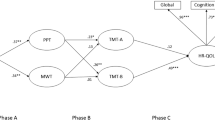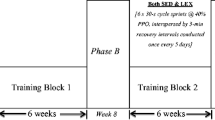Abstract
Objective
To assess the relationship between fitness levels and components, sitting time and health-related quality of life (HRQoL), over time among community-dwelling older adults.
Methods
Three different sitting trajectories were calculated: (i) no change; (ii) decrease; and (iii) increase in ST, between baseline and follow-up. Fitness was assessed using the aerobic capacity, upper and lower limb strength, and total fitness. Participants were classified into higher (75th percentile or above) or lower (below 75th percentile) fitness levels, using the fitness tests. HRQoL scores at follow-up were compared to the three different sitting time trajectories within and across both the higher and the lower fitness groups for each of the three fitness indexes.
Results
Greater HRQoL scores were observed in those participants that decreased their ST as compared with those increasing their sitting time over time for participants classified in the lower end of their aerobic capacity or total fitness index. No differences were detected in HRQoL scores in people classified in the higher fitness level group for any of the fitness indexes. Participants that increased or did not change their sitting time and who were classified in the higher fitness end of aerobic capacity and total fitness index self-reported higher HRQoL scores when compared with those in the lower fitness end.
Conclusion
Increased sitting time over time is associated with poorer HRQoL in older adults. Higher fitness levels could help attenuate the negative impact of sitting over time.


Similar content being viewed by others
References
Huber, M., Knottnerus, J. A., Green, L., van der Horst, H., Jadad, A. R., Kromhout, D., et al. (2011). How should we define health? BMJ: British Medical Journal,343, d4163.
Tisminetzky, M., Bayliss, E. A., Magaziner, J. S., Allore, H. G., Anzuoni, K., Boyd, C. M., et al. (2017). Research priorities to advance the health and health care of older adults with multiple chronic conditions,65(7), 1549–1553.
Riviere, D. (2016). Promoting exercise and sports activities among the elderly. Soins Gerontologie,21(120), 12–14.
Carver, L. F., & Buchanan, D. (2016). Successful aging: Considering non-biomedical constructs. Clinical Interventions in Aging,11, 1623–1630.
Santos, D. A., Silva, A. M., Baptista, F., Santos, R., Vale, S., Mota, J., et al. (2012). Sedentary behavior and physical activity are independently related to functional fitness in older adults. Experimental Gerontology,47(12), 908–912.
Munoz-Arribas, A., Vila-Maldonado, S., Pedrero-Chamizo, R., Espino, L., Gusi, N., Villa, G., et al. (2014). Physical fitness evolution in octogenarian population and its relationship with a sedentary lifestyle. Nutricion Hospitalaria,29(4), 894–900.
Beauchamp, M. K., Lee, A., Ward, R. F., Harrison, S. M., Bain, P. A., Goldstein, R. S., et al. (2017). Do exercise interventions improve participation in life roles in older adults? A systematic review and meta-analysis. Physical Therapy,97(10), 964–974.
Choi, M., Prieto-Merino, D., Dale, C., Nuesch, E., Amuzu, A., Bowling, A., et al. (2013). Effect of changes in moderate or vigorous physical activity on changes in health-related quality of life of elderly British women over seven years. Quality of Life Research: An International Journal of Quality of Life Aspects of Treatment, Care and Rehabilitation,22(8), 2011–2020.
Taguchi, N., Higaki, Y., Inoue, S., Kimura, H., & Tanaka, K. (2010). Effects of a 12-month multicomponent exercise program on physical performance, daily physical activity, and quality of life in very elderly people with minor disabilities: An intervention study. Journal of Epidemiology,20(1), 21–29.
Gusi, N., Hernandez-Mocholi, M. A., & Olivares, P. R. (2015). Changes in HRQoL after 12 months of exercise linked to primary care are associated with fitness effects in older adults. European Journal of Public Health,25(5), 873–879.
Moratalla-Cecilia, N., Soriano-Maldonado, A., Ruiz-Cabello, P., Fernandez, M. M., Gregorio-Arenas, E., Aranda, P., et al. (2016). Association of physical fitness with health-related quality of life in early postmenopause. Quality of Life Research: An International Journal of Quality of Life Aspects of Treatment, Care and Rehabilitation,25(10), 2675–2681.
Bray, N. W., Smart, R. R., Jakobi, J. M., & Jones, G. R. (2016). Exercise prescription to reverse frailty. Applied Physiology, Nutrition and Metabolism,41(10), 1112–1116.
Pedrero-Chamizo, R., Gomez-Cabello, A., Delgado, S., Rodriguez-Llarena, S., Rodriguez-Marroyo, J. A., Cabanillas, E., et al. (2012). Physical fitness levels among independent non-institutionalized Spanish elderly: The elderly EXERNET multi-center study. Archives of Gerontology and Geriatrics,55(2), 406–416.
Joseph, J. J., Echouffo-Tcheugui, J. B., Golden, S. H., Chen, H., Jenny, N. S., Carnethon, M. R., et al. (2016). Physical activity, sedentary behaviors and the incidence of type 2 diabetes mellitus: The Multi-Ethnic Study of Atherosclerosis (MESA). BMJ Open Diabetes Research & Care,4(1), e000185.
Despres, J. P. (2016). Physical activity, sedentary behaviours, and cardiovascular health: When will cardiorespiratory fitness become a vital sign? The Canadian Journal of Cardiology,32(4), 505–513.
van Roekel, E. H., Winkler, E. A., Bours, M. J., Lynch, B. M., Willems, P. J., Meijer, K., et al. (2016). Associations of sedentary time and patterns of sedentary time accumulation with health-related quality of life in colorectal cancer survivors. Preventive Medicine Reports,4, 262–269.
Sardinha, L. B., Magalhaes, J. P., Santos, D. A., & Judice, P. B. (2017). Sedentary patterns, physical activity, and cardiorespiratory fitness in association to glycemic control in type 2 diabetes patients. Frontiers in Physiology,8, 262.
Ekblom-Bak, E., Ekblom, O., Bolam, K. A., Ekblom, B., Bergstrom, G., & Borjesson, M. (2016). SCAPIS pilot study: Sitness, fitness and fatness—Is sedentary time substitution by physical activity equally important for everyone’s markers of glucose regulation? Journal of Physical Activity and Health,13(7), 697–703.
Gomez-Cabello, A., Pedrero-Chamizo, R., Olivares, P. R., Luzardo, L., Juez-Bengoechea, A., Mata, E., et al. (2011). Prevalence of overweight and obesity in non-institutionalized people aged 65 or over from Spain: The elderly EXERNET multi-centre study. Obesity Reviews: An Official Journal of the International Association for the Study of Obesity,12(8), 583–592.
EuroQol. (1990). A new facility for the measurement of health-related quality of life. Health Policy (Amsterdam, Netherlands),16(3), 199–208.
Lopez-Rodriguez, C., Laguna, M., Gomez-Cabello, A., Gusi, N., Espino, L., Villa, G., et al. (2017). Validation of the self-report EXERNET questionnaire for measuring physical activity and sedentary behavior in elderly. Archives of Gerontology and Geriatrics,69, 156–161.
van der Ploeg, H. P., Chey, T., Korda, R. J., Banks, E., & Bauman, A. (2012). Sitting time and all-cause mortality risk in 222 497 Australian adults. Archives of Internal Medicine,172(6), 494–500.
Rikli, R. E. (2000). Reliability, validity, and methodological issues in assessing physical activity in older adults. Research Quarterly for Exercise and Sport,71(2 Suppl), S89–S96.
Rebar, A. L., Duncan, M. J., Short, C., & Vandelanotte, C. (2014). Differences in health-related quality of life between three clusters of physical activity, sitting time, depression, anxiety, and stress. BMC Public Health,14, 1088.
Balboa-Castillo, T., Leon-Munoz, L. M., Graciani, A., Rodriguez-Artalejo, F., & Guallar-Castillon, P. (2011). Longitudinal association of physical activity and sedentary behavior during leisure time with health-related quality of life in community-dwelling older adults. Health and Quality of Life Outcomes,9, 47.
Rosenkranz, R. R., Duncan, M. J., Rosenkranz, S. K., & Kolt, G. S. (2013). Active lifestyles related to excellent self-rated health and quality of life: Cross sectional findings from 194,545 participants in The 45 and Up Study. BMC Public Health,13, 1071.
Bampton, E. A., Johnson, S. T., & Vallance, J. K. (2015). Profiles of resistance training behavior and sedentary time among older adults: Associations with health-related quality of life and psychosocial health. Preventive Medicine Reports,2, 773–776.
Omorou, A. Y., Vuillemin, A., Menai, M., Latarche, C., Kesse-Guyot, E., Galan, P., et al. (2016). 10-year cumulative and bidirectional associations of domain-specific physical activity and sedentary behaviour with health-related quality of life in French adults: Results from the SU.VI.MAX studies. Preventive Medicine,88, 66–72.
Bellettiere, J., Winkler, E. A. H., Chastin, S. F. M., Kerr, J., Owen, N., Dunstan, D. W., et al. (2017). Associations of sitting accumulation patterns with cardio-metabolic risk biomarkers in Australian adults. PLoS ONE,12(6), e0180119.
Ingle, L., Mellis, M., Brodie, D., & Sandercock, G. R. (2017). Associations between cardiorespiratory fitness and the metabolic syndrome in British men. Heart (British Cardiac Society),103(7), 524–528.
Loprinzi, P. D. (2015). Joint associations of objectively-measured sedentary behavior and physical activity with health-related quality of life. Preventive Medicine Reports,2, 959–961.
Bouaziz, W., Vogel, T., Schmitt, E., Kaltenbach, G., Geny, B., & Lang, P. O. (2017). Health benefits of aerobic training programs in adults aged 70 or over: A systematic review. Presse Medicale (Paris, France: 1983),46(9), 794–807.
De Mello, M. T., de Aquino Lemos, V., Antunes, H. K., Bittencourt, L., Santos-Silva, R., & Tufik, S. (2013). Relationship between physical activity and depression and anxiety symptoms: A population study. Journal of Affective Disorders,149(1–3), 241–246.
Favejee, M. M., van den Berg, L. E., Kruijshaar, M. E., Wens, S. C., Praet, S. F., Pim Pijnappel, W. W., et al. (2015). Exercise training in adults with Pompe disease: The effects on pain, fatigue, and functioning. Archives of Physical Medicine and Rehabilitation,96(5), 817–822.
Soer, R., Reneman, M. F., Speijer, B. L., Coppes, M. H., & Vroomen, P. C. (2012). Clinimetric properties of the EuroQol-5D in patients with chronic low back pain. The Spine Journal: Official Journal of the North American Spine Society,12(11), 1035–1039.
Goldsmith, K. A., Dyer, M. T., Schofield, P. M., Buxton, M. J., & Sharples, L. D. (2009). Relationship between the EQ-5D index and measures of clinical outcomes in selected studies of cardiovascular interventions. Health and Quality of Life Outcomes,7, 96.
Kim, J., Im, J. S., & Choi, Y. H. (2017). Objectively measured sedentary behavior and moderate-to-vigorous physical activity on the health-related quality of life in US adults: The National Health and Nutrition Examination Survey 2003-2006. Quality of Life Research: An International Journal of Quality of Life Aspects of Treatment, Care and Rehabilitation,26(5), 1315–1326.
Owen, N., Healy, G. N., Matthews, C. E., & Dunstan, D. W. (2010). Too much sitting: the population health science of sedentary behavior. Exercise and Sport Sciences Reviews,38(3), 105–113.
Owen, N. (2012). Sedentary behavior: Understanding and influencing adults’ prolonged sitting time. Preventive Medicine,55(6), 535–539.
Funding
This study was supported by funds from the IMSERSO (Grant Nos. 104/07 and 147/11), by the Ministerio de Economía y Competitividad of the Government of Spain (Grant Number (DEP2016-78309-R) (MINECO/FEDER, EU), by the Biomedical Research Networking Center for Physiopathology of Obesity and Nutrition (CIBEROBN- CB12/03/30038), by the Biomedical Research Networking Center on Frailty and Healthy Aging (CIBERFES), by the Ministerio de Educación y Ciencia (Red EXERNET DEP2005-00046), and FEDER funds from the European Union (CB16/10/00477). In addition, MMG has received a PhD. grant from the Ministerio de Educación, Cultura y Deporte, Spain (AP2010-5476).
Author information
Authors and Affiliations
Corresponding author
Additional information
Publisher's Note
Springer Nature remains neutral with regard to jurisdictional claims in published maps and institutional affiliations.
O. López-Torres and B. del Pozo-Cruz contributed equally to this work.
Rights and permissions
About this article
Cite this article
López-Torres, O., del Pozo-Cruz, B., Maroto-Sánchez, B. et al. Does fitness attenuate the relationship between changes in sitting time and health-related quality of life over time in community-dwelling older adults? Evidence from the EXERNET multicenter longitudinal study. Qual Life Res 28, 3259–3266 (2019). https://doi.org/10.1007/s11136-019-02252-3
Accepted:
Published:
Issue Date:
DOI: https://doi.org/10.1007/s11136-019-02252-3




